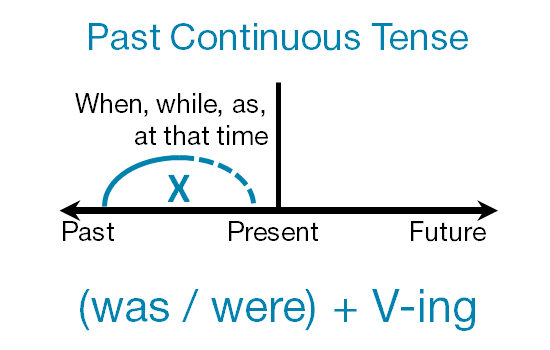The Past Continuous (or progressive) is a verb tense that indicates actions or events that were in progress at a particular time in the past. The word ‘continuous’ (or ‘progressive’) shows that the action was continuing or in progress.
We generally use the Past Continuous to talk about actions and states in progress (happening) around a particular time in the past. It can emphasize that the action or state continued for a period of time in the past.
Here’s an illustration of what Past Continuous means:



- Jane was reading a book when I came in.
- This time last week I was hiking in the Alps.
- Did they have time to see the sights of Rome?
- Not really. They were playing football all weekend.
How to form Past Continuous
To make the Past Continuous, use:
was/were + the ‘-ing’ form of the verb (Present Participle)
| Note: To form the Present Participle we add ‘-ing’ to the base form of the verb. For spelling rules when adding ‘-ing’, see our article on participles. |
| Singular | Plural |
| I was walking You were walking He/she/it was walking | We were walking You were walking They were walking |
- I was listening to my iPod, so I didn’t hear the fire alarm.
- Last night at 6 PM, I was eating dinner.
When to use Past Continuous
The Past Continuous is used to convey the following meanings.
Actions in progress at a time in the past
Past Continuous is used to show something was happening at some point in the past. This point may be expressed as a certain time or another action in the past. Words that often signal this tense: while, during.
- I was living in Singapore during the 1990s.
- We were trying to fix the computer earlier.
Interrupted actions in the past
Past Continuous is often used to describe what was going on when a particular event happened or to give the reason for a past event. That continuing action in the past is usually interrupted by a shorter action in the Past Simple:
- We were eating lunch when somebody knocked on the door.
- The last time I saw him, he was washing his car.
- She didn’t go out because she was working late.
- I forgot about my meal because I was talking on the phone.
Parallel actions
If we use Past Continuous with two actions in the same sentence, it means that both actions were happening at the same time. Words that often signal this tense: while, as.
- I was lying on the bed while I was reading.
- We were ordering food and you were interrupting.
Background
We often use the Past Continuous to describe the background of a story. For example, we can talk about the weather or what people were doing before the story (event, action) started:
- It was a beautiful day. The sun was shining and the birds were singing. Children were laughing and playing in the street. Suddenly a heavy grey cloud appeared in the sky.
Irritating or annoying habits
We can use Past Continuous to describe irritating or annoying habits that were happening in the past. We usually use ‘always,’ ‘constantly,’ ‘continuously,’ ‘continually’ in these sentences.
- She was always coming to class late.
- He was constantly talking. He annoyed everyone.
Polite questions
It means using a particular tone when inquiring. This is typical for formal situations.
- I was hoping you would tell me.
- I was wondering if you know how to get there.
Non-continuous verbs
It is important to remember that non-continuous verbs cannot be used in any continuous tenses. Instead of using Past Continuous, we must use Past Simple.
- Kate was at my house when he arrived.
- NOT: K
atewas beingat my house when he arrived.
Watch this video from AMES836 to understand what Past Continuous means and how it is used:
More on Past Continuous: